Location: Scotland
PROLOGUE
IN A BBC INTERVIEW, author Lionel Shriver discussed the ‘Five Minutes to Twelve Syndrome.’ Shriver elaborated:
‘It’s a tendency to push things to the very limit. You want to get that last little bit of good life before making decisions to prepare yourself for the bad life. Therefore you never make preparations, and you are simply victimised by circumstance.’
Shriver was talking specifically about mortality and death, in terms of our individual preparedness; but the global resonances of this ‘syndrome’ also strike a terrifying environmental chord. It personifies a mind-set, a consumer-based paradigm, market-orientated and gluttonous. In terms of human behaviour, it reveals a deadly tendency regarding resource management within the industrialised/post-industrialist age. It captures the zeitgeist of how many individuals, organisations and even countries are behaving. We are Roadrunner and Wile E.Coyote locked into a chase scene of sea-rising, resource-depleting, globally-warming proportions that is triggering irrevocable tipping points. Surrounded by STOP signs (and dying canaries) the juggernauts of expansion and growth continue on apace.
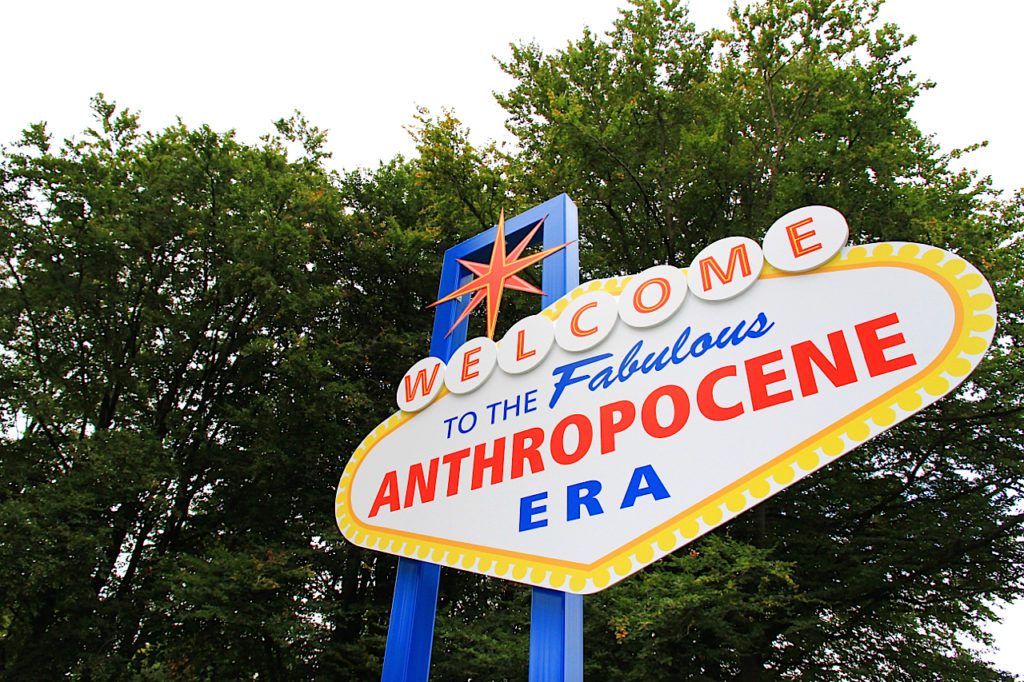
HABITUS, Robyn Woolston, Edge Hill University Arts Centre Commission, Ormskirk, UK (2013)
Within this context I am a cultural worker who creates installations, films and site-responsive works:
‘Robyn often examines issues that others shy away from, from difficult emotions to consumer waste. In so doing, she seeks to make visible that which is forgotten, left behind and discarded.’ – Ann Bukantas, Head of Fine Art. National Museums Liverpool
To elaborate, I situate the framework of my research methodologies by referencing Coessens, Crispin and Douglas in their publication: ‘The Artistic Turn: A Manifesto’ (2009). To some extent, they develop ideas laid down by Lakoff and Johnson. Collectively they explore the fields of research, music and art. Their publication offers a clearly articulated blueprint for the development of an alternative, integrated, artistic research discipline that counters Cartesian dualism.
Artistic research is …practice led research, but founded on a practice that is very complex, linking body, material and thought together in the creation of unique assemblages of knowledge, feelings and skill and directed towards artefacts and/or performances. The Practice of artistic research offers a kind of meta-practice, a research practice that reflects on the artist’s own artistic practice with all the rigour and focus of the research mentality but from an interior, experientially-informed perspective.’ (Coessens, 2009, p94)
Their manifesto proposes that arts practice offers a kind of potency and authenticity, because of its embodied nature and situated context, in a way that scientific approaches to the field cannot encompass. It is the nature or ecology of the situation that informs the context and content for the researcher, in the first instance, and then subsequently the receiver of that knowledge ‘exchange’ in terms of the knowledge intuited, laterally. By definition the artist’s personification necessitates that ‘…he or she has an embodied, perceptual and cognitive commitment to the exterior world.’ (Coessens, 2009)
Situating and rooting arts practice at the centre of multiple and tentacular (Haraway) points of reference, ecological urgencies and political dynamics provides the opportunity to disrupt and dislodge proportions of the rapacious and scarifying processes that continue to feed the climate crisis. Embodied responses bear witness whilst layering cultural meaning because ‘ to avoid becoming a slideshow a contemporary critical performance practice must pitch itself at the heart of the fairground, where the most dangerous rides hold sway.’ (Kershaw, 1990)
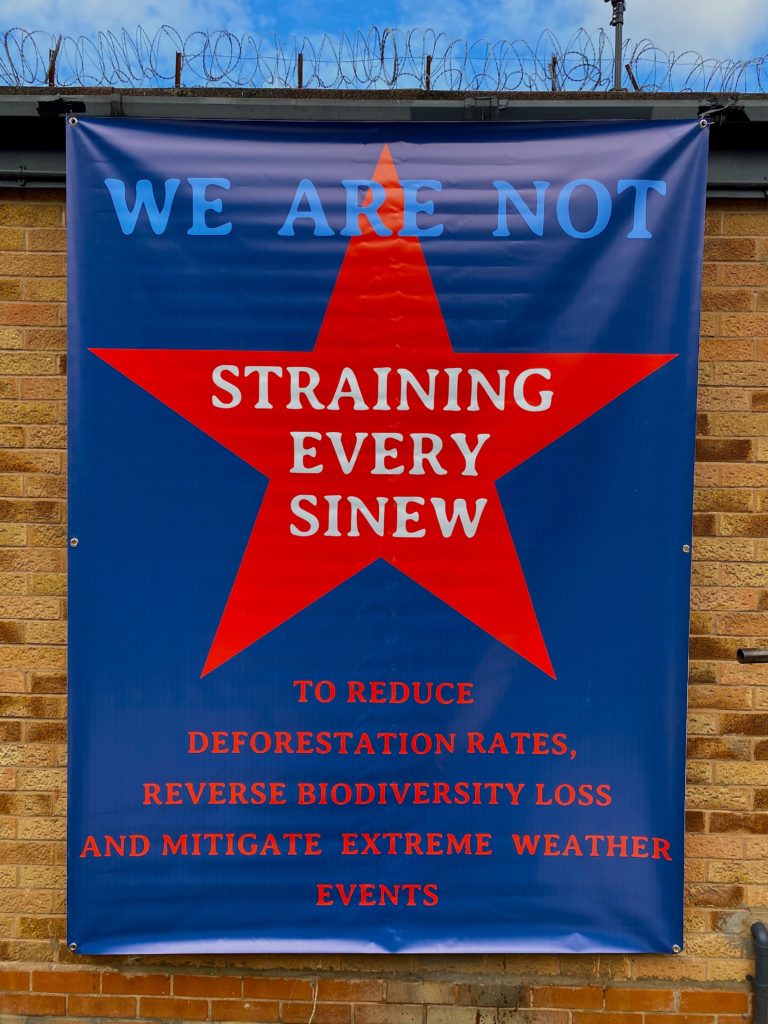
STRAINING EVERY SINEW, Robyn Woolston, as part of Quiet Carnival, Friction Arts, Birmingham, UK (2020)
What follows are notes on a series of works focusing upon material-cultures, land-use and the Rites-of-Passage that connect the two.
I. PLASTICITY versus PLASTIC
PLASTICITY REFERS TO the adaptability, flexibility and dynamism of an organism in the face of changes to its environment or differences between its habitats. On a nation-state level It’s what’s required when our waters become fouled by manufactured pollutants in terms of regulatory action whilst our species numbers decline to extinction-indicator levels. Ironically, it’s plasticity that allows plastic (synthetic or semi-synthetic) to be moulded, extruded or pressed into solid objects. Objects which, in turn, embody a ‘structurally persistent’ quality akin to amber, lasting hundreds if not thousands of years yet hold none of the equivalent value. Once this adaptability-and-dynamism has been utilised, and supposedly spent, these objects transition and are labelled ‘rejected matter’ and become part of the world’s largest open-loop processing systems. As little as 9% of the original product created is in fact recycled. In terms of accumulated mass we now live side-by-side with between 1 to 8 billion tons of discarded plastic waste (depending on which reports you track). Plastic micro-particles persist within the deepest oceans of the world, on top of the highest mountains and inside of the fish on our plates. Micro-plastics have even been found within the placentas of new-born babies.
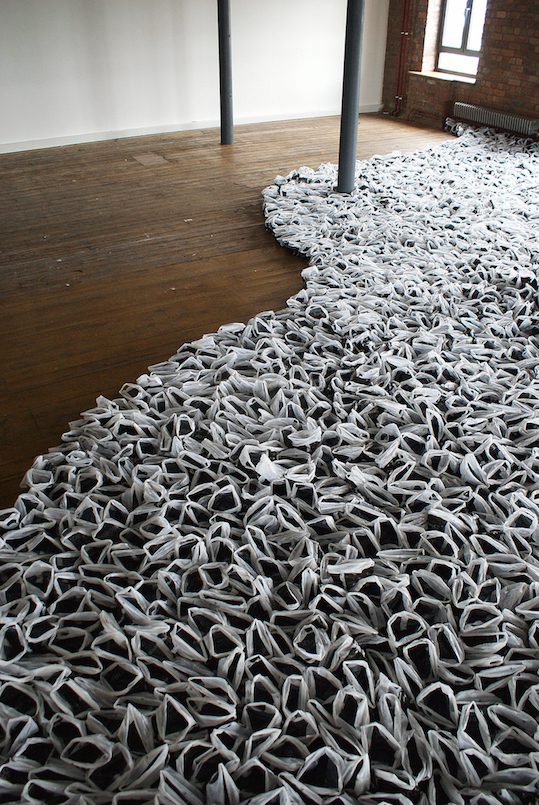
FIELD OF DREAMS, Robyn Woolston, Threshold Festival, Novas Contemporary Urban Centre, Liverpool, UK (2011)
I began working with plastic waste in 2007 when I had acquired 7500 discarded ice-cream containers for my graduation show. What followed were installations that contained 45,000 plastic bags ( ‘Field of Dreams’ – 2011); 132,000 knives and forks ( ‘Smart Price’ in 2012 and ‘Last’ in 2012); and 3.6 tons of post-consumer plastic waste ( ‘Strangers in a Strange Land’ – 2013).
In 2017 this work culminated in a commission for the Art in Manufacturing strand of the inaugural National Festival of Making in the UK.
Revolution (2017) Statement:
Thousands of waste plastic pieces form an immersive installation which also houses a documentary film. The 1st Industrial Revolution is referenced against the context of the current 4th Industrial Revolution alongside interviews with current manufacturing staff and local historians. Historical parallels proliferate from the increased sophistication of mechanised processes to the expansion of global trade. Design, fabrication and plastic moulding processes are shown in parallel with the ebb and flow of the Leeds to Liverpool canal. Culminating in a meditation upon Lancashire-based manufacturing and its legacy.
REVOLUTION Cam/Ed/Dir: Robyn Woolston, an Art in Manufacturing commission as part of the National Festival of Making, Blackburn, UK (2017)
Whilst all of my plastic-based works trade on the rich cultural provenance of the Readymade, they also continue to ask questions of the viewer, or activating ‘agent’ in the case of the installation based works, in terms of value. Sometimes directly with ‘Last’ (2012), and its neon sign which could only be viewed by entering a tower whose floor was thickly laden with cutlery that had been rejected by the manufacturing processes behind the Walmart/Asda chain. To enter the space your feet had to literally break the surface of the ‘evil snow’ (as one viewer named it), the environmental footprint embodied in an experiential installation.
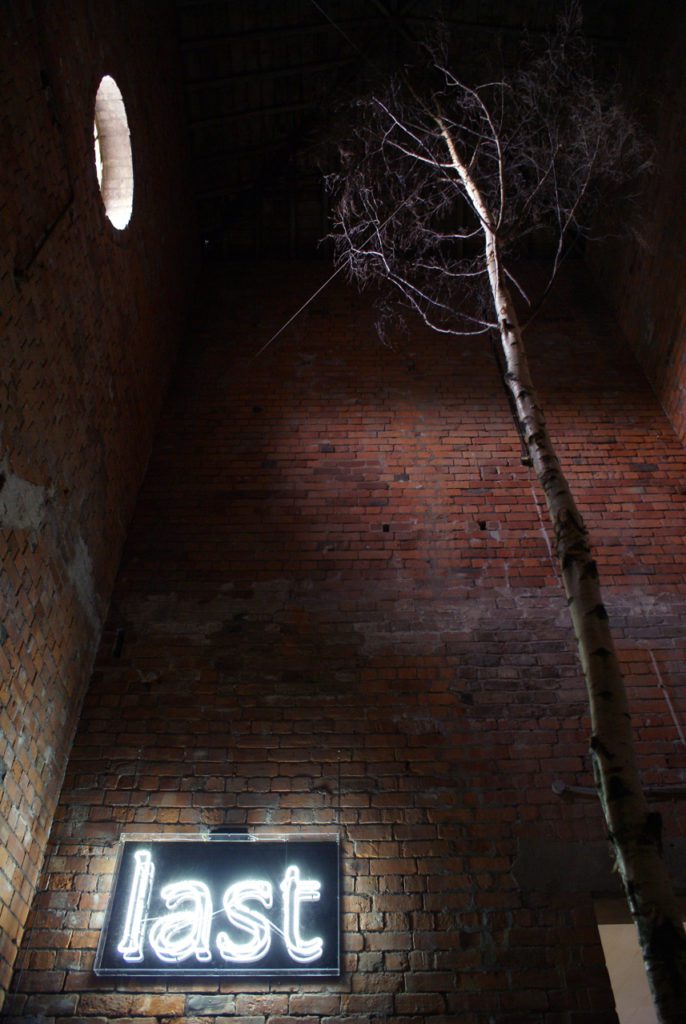
LAST, Robyn Woolston, Metal, Edge Hill Railway Station, Tunnel Rd, Liverpool, UK (2012)
Sometimes correlations are more symbolic. In ‘Strangers in a Strange Land‘ (2013) 3.6 tons of post-consumer grade plastic waste formed 9 bales that sat side-by-side with a Henry Moore sculpture. The installation mirrored the ornate structure of the gold leaf ceiling found above and existed as a meditation upon Carl Andre’s infamous Equivalent VIII (1966), a sculpture created from 120 firebricks. Like Andre’s bricks, the bales had a double-meaning; they were waste yet embodied value. They had been both discarded and harvested.
Further information on the context of that work can be found here.
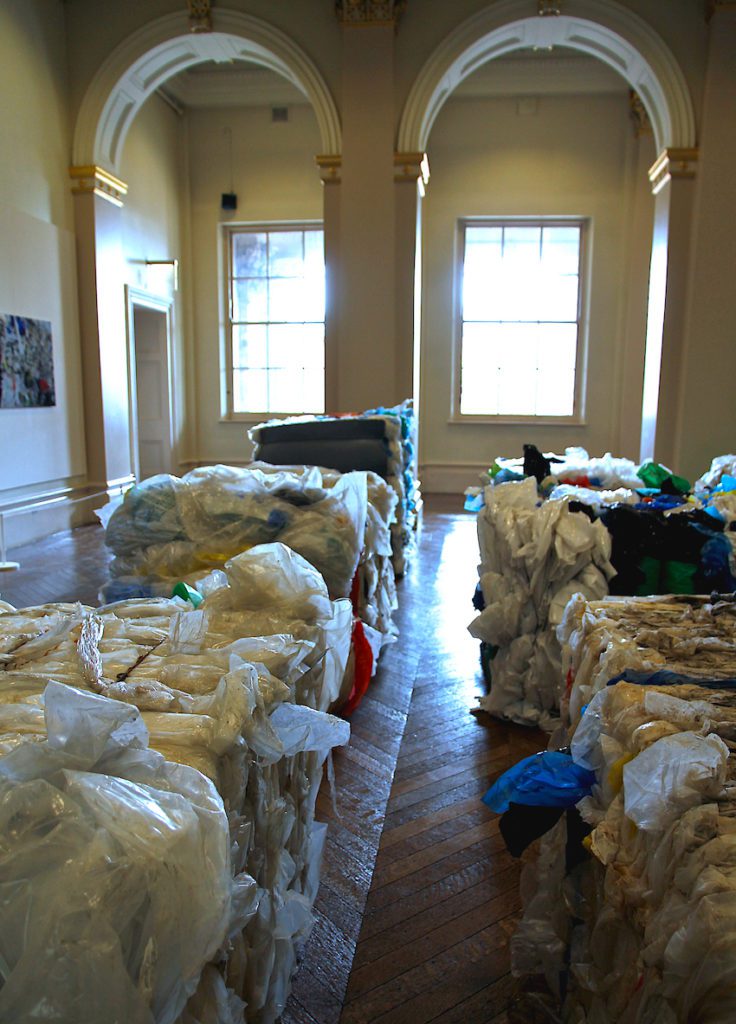
STRANGERS IN A STRANGE LAND, Robyn Woolston, Walker Art Gallery, Liverpool, UK (2013)
II. ON DEATH AND DYING
WHEN MY MOTHER DIED IN 2009 I was thrust into a not-so-brave New World. A hard shoulder-punch catapulted me through an alchemical doorway, irrevocably altering my relationship to materials, processes and practice.
A rite of passage is something that happens to an individual – and as such, is a particularly intense personal experience – but it is at the same time social and in most cases institutional.’ (Greenblatt, S. 1995)
In response I embarked upon an MA by Research that explored how autobiographical output exemplifies an embodied response to the phenomena of life, and therefore is representative of a lived experience rooted within the cognitive unconscious as well as the culturally situated. It explored how society reiterates dialogues about the dialogues that are perpetually represented, whilst underlining how if a rite of passage concerning death is not collectively represented we cannot refer to it as a meta-narrative of our age despite its continual presence within our lives. I referenced the personal, intimate and autobiographical severing of my matrilineal line alongside exploring the global, cultural and social reality of the Holocaust as manifest within the Mauthausen Concentration Camp.
ET IN ARCADIA EGO: THERE IS DEATH EVEN IN UTOPIA, Cam/Ed/Dir: Robyn Woolston, Mauthausen concentration camp, Austria (2010)
Death is often seen to exist within two frameworks, a physical manifestation within the body of its captor and within the destination of its social context, in terms of how it is revered, displayed and received. But there is a third place of ‘residence’ that belongs both within the body of its receiver as well as the social/cultural/familial body and it is referred to as a Rite of Passage. What begins to occur when we delve deeply into the structure and exposition of this phenomena (as something we collectively share via existence and communion) also reveals the messy, organic, nature of the experiential gestalt.
The ecological philosopher and multispecies ethnographer Thom Van Dooren elaborates:
Mourning is about dwelling with a loss and so coming to appreciate what it means, how the world has changed, and how we must ourselves change and renew our relationships if we are to move forward from here. In this context, genuine mourning should open us into an awareness of our dependence on and relationships with those countless others being driven over the edge of extinction. The reality, however, is that there is no avoiding the necessity of the difficult cultural work of reflection and mourning. This work is not opposed to practical action, rather it is the foundation of any sustainable and informed response.
HARVESTMENT, Cam/Ed/Dir: Robyn Woolston, São Paulo (Brazil), Peterborough (England), the Highlands (Scotland) (2015)
‘Harvestment’ review
Collectively the vignettes raise fundamental questions about how we use and shape our natural environment to our own ends, constructing and destroying, manipulating and managing for profit and gain.There is also real beauty here, and a genuine respect for the workers who toil on production lines to meet consumer demands or clean up our mess.The cycles of life and death are evident, and the stark juxtapositions of wealth and poverty, celebration and despair, verdant abundance and polluted wasteland, chaos and order.This is a beautiful and thought provoking piece. – Mark Richards, Director, Metal (Peterborough)
Kristeva references the questioning and dislocated state that artists can find themselves in, in terms of the postmodern hybridisation of cultures and the ‘experience’ of creating within that paradigm, as a two-fold construct that fashions work that offers ‘…on one side the most violent fragmentation and abjection, on the other, in the background, an inquiry into the state of the world’ (Kristeva, 1995).
Set against this context my work around mortality attempts to synthesise and coagulate a matrix of meanings that stem from both my personal relationship to death and our collective experience of it. It is mirrored within my practice when working with waste materials. Embodiment, a la Merleau-Ponty, is at the very heart of cognition and response. Indeed within the University of Minnesota Press publication ‘Arts of Living on a Damaged Planet’ (2017) the introductory essay ‘Haunted Landscapes of the Anthropocene’ references the fact that ‘ an extinction is a local event as well as a global one’.
YOURS, IN ECOCIDE, Cam/Ed/Dir: Robyn Woolston (2021)
If we don’t fully understand and situate the deaths of our loved ones, then how do we begin to grieve for a planet that is experiencing its own 6th mass extinction? Perhaps most pertinently, how do we respond in the most effective ways to the crisis if we are unable to face and process its magnitude personally?
Within The Multispecies Salon, Deborah Bird Rose calls the layering of complex traumas we currently face a Double Death: ‘ The balance between life and death is over-run, and a relentless cascade is piling up corpses in the land of the living.’ She continues: ‘Double death is an open secret and an open wound. At this time it is driven by humans: it is the mirror on the wall.’ We perhaps exist within a time of Great Uncoupling, of a gross estrangement from the natural rhythms of life. A sense of the natural order of life has potentially accelerated and distorted our sense of connection to one another and the full cycle of life.
III. 5000 YEARS OF SUSTAINABILITY v. COLLAPSING FUTURES
TO MOVE FORWARD WITH reflexivity we must also look back. As the English composer Sir Michael Tippet wrote in A Child of Our Time (a composition begun on the day World War II was declared): ‘I would know my shadow and my light.’
Despite the ever-present barrage of commercialised meta-narratives that still hold sway, we must strive to recognise and synthesise the importance of our interconnectivity, of our bones and being.
A study published in June 2021 in PNAS (Proceedings of the National Academy of Sciences of the United States of America) found that the indigenous populations of the Amazon Rainforest have lived for thousands of years without damaging its ecosystem or contributing to any detectable species loss. They were innately sustainable yet today. ‘ Living arrangements that took millions of years to put into place are being undone in the blink of an eye. The hubris of conquerors and corporations makes it uncertain what we can bequeath to our next generations, human and non human.’ (Tsing A. et al, Ed Arts of Living on a Damaged Planet: Ghosts and Monsters of the Anthropocene)
In 2018 I attended Open Engagement (OE), a three-day, artist-led conference dedicated to expanding the dialogue around socially engaged art whilst creating a site of care for its development. Lucy Lippard delivered a keynote speech there which I recorded for reference. Over the next three years a phrase of hers consistently and methodically came back to me: ‘Land belongs to itself.’ Earlier this year I contacted Lippard because I had woven her audio and sentiments into an eco-poetic film utilising the same phrase ‘Land Belongs to Itself’ (2021). The arterial A9 road in Scotland, acres of agri-forestry and a hydro-dam form elements of the visual offer:
LAND BELONGS TO ITSELF, Cam/Ed/Dir: Robyn Woolston, the Highlands, Scotland (2021)
IV. CONCLUSION
MY PRACTICE STEMS FROM a belief that an authentic understanding and knowledge of our nature and our growth cannot be ‘bought’ but only known, uncovered, recognised, shared and acknowledged; and ultimately ‘lived through’. Such work involves a dialectic and discursive framework of trans-subjectivity; of connection to the mythic and the circular, the holistic and the shared, and of the aforementioned ‘values and issues’ of life. This means working with the waste and the rejects, the filth and the traumatic.
Double-Death scenarios are birthing new narratives each and every day. As makers-of-meaning, artists, dancers, minstrels, artisans, gardeners, chefs, poets, filmmakers and writers must reflect and review, revealing interconnections and consequences.
Cyrulnik talks ‘… of playing on the edge of the grave’ (Cyrulnik, 2007) whilst Kristeva comments that we must be ‘…as close as possible to the crisis, to accompany it and produce individual works because that is the predicament we are in, in a kind of pulverisation and solitude’ (Kristeva, 1995). Both provide grounding for a knowledge-base and acceptance of heightened states, or rites of passage. They articulate the basis of autobiographical revelation that creates embedded, value-laden, outputs.
ENDNOTES
Sections of my essay are ‘expansions’ from the following pre-existing articles:
https://www.academia.edu/4004327/Edge_Lands_Emotional_Vulnerability_and_Physical_Waste_A_Critique
https://www.academia.edu/44078408/TEXAS_R_WOOLSTON_ARTISTS_TALK_2019
Woolston, Robyn. MA by Research Thesis: AN EXPLORATION OF AUTOBIOGRAPHICAL ART-WORK THAT EXEMPLIFIES A PERSONAL RITE-OF-PASSAGE CONCERNING DEATH. Manchester Institute for Research and Innovation in Art and Design (MIRIAD) (2011)
WEBSITES
https://www.multispecies-salon.org/double-death/
https://www.pnas.org/content/early/2021/06/04/2022213118
A 5,000-year vegetation and fire history for tierra firme forests in the Medio Putumayo-Algodón watersheds, northeastern Peru. Authors: Dolores R. Piperno, Crystal H. McMichael, Nigel C. A. Pitman, Juan Ernesto Guevara Andino, Marcos RÃos Paredes, Britte M. Heijink, and Luis A. Torres-Montenegro
BOOKS
Tsing A, Swanson H, Gan E, and Bubandt N, Ed. (2017), Arts of Living on a Damaged Planet: Ghosts and Monsters of the Anthropocene
Bishop, Claire (2005) Installation Art, Tate Publishing, London
Capra, Fritjof (1996) The Web of Life. A New Synthesis of Mind and Matter, Harper Collins, London
Capra, Fritjof (2003) The Hidden Connections, 2nd edn, Flamingo, London
Coessens, Kathleen, Darla Crispin & Anne Douglas (2009) The Artistic Turn: A Manifesto, Leuven University Press, Belgium
Coult, Tony (1990) One Foot on the Ground, One Foot Moving in Coult, Tony & Baz Kershaw Engineers of the Imagination: The Welfare State Handbook, Methuen Drama, London
Cyrulnik, Boris (2007) Talking of Love on the Edge of a Precipice, trans. David Macey, Penguin, London [2005]
Dooren, Thom van (2014) Life and Loss at the Edge of Extinction, Columbia University Press
Gray, Carole + Julian Malins (2004) Visualizing Research: A Guide To The Research Process In Art And Design, Ashgate Publishing, Surrey
Greenblat, S (1995) Liminal States and Transformations in Morgan, Stuart & Frances Morris Rites of Passage: Art for the End of the Century, Tate Gallery Publications, London
Haraway, Donna (2016) Staying with the Trouble: Making Kin in the Chthulucene. Duke University Press
Hooks, Bell (1995) Art on My Mind: Visual Politics, The New Press, New York
Kaprow, Alan (2003) Essays on the Blurring of Art and Life, Expanded edn, University of California Press, CA
Kristeva, Julia (1995) ‘Of Word and Flesh‘ in Morgan, Stuart & Frances Morris Rites of Passage: Art for the End of the Century, Tate Gallery Publications, London
Lakoff, George (1987) Women, Fire and Dangerous Things, University Of Chicago Press, Chicago
Lakoff, George & Mark Johnson (1980) Metaphors We Live By, University Of Chicago Press, Chicago
Lakoff, George & Mark Johnson (1995) Philosophy in the Flesh, University Of Chicago
Press, Chicago
Morgan, Stuart & Frances Morris (1995) Rites of Passage: Art for the End of the Century, Tate Gallery Publications, London
Moustakis, Clark (1990) Heuristic Research: Design, Methodology and Applications, Sage Publications, London
Townsend, Chris (2008) Art and Death, London: I.B.Tauris and Co
WEAD MAGAZINE ISSUE No. 12, TAKING ACTION
Published October 2021
